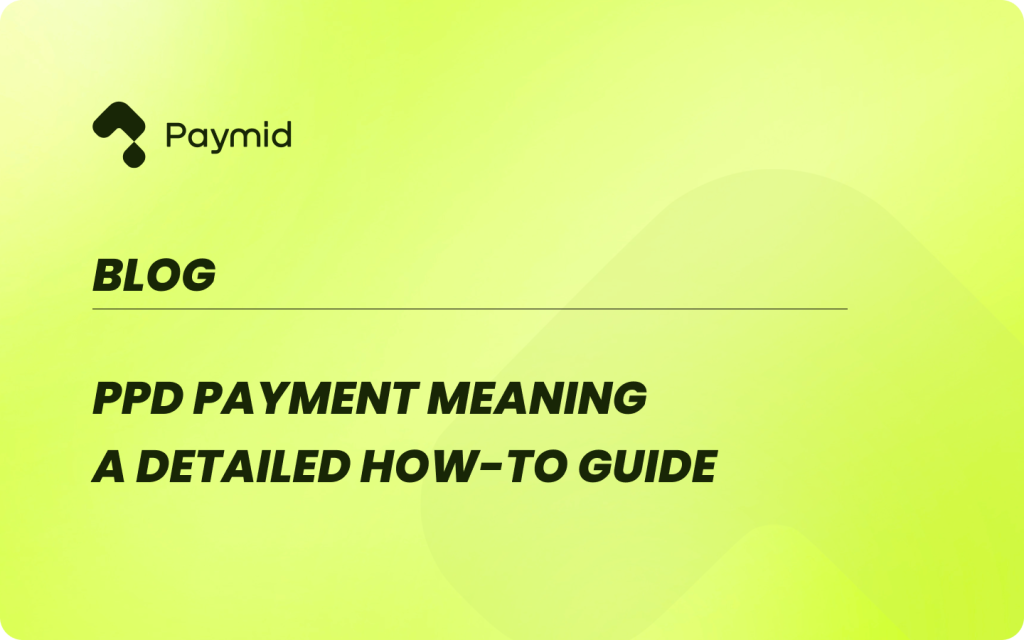PPD Payment Meaning: A Detailed How-to Guide

PPD payment meaning often eludes many individuals and businesses alike. This acronym, Prearranged Payment and Deposit, is crucial in various financial transactions, including tax refunds, direct deposits, and utility bill payments.
Understanding PPD payments is essential for anyone involved in electronic fund transfers. These transactions, governed by NACHA (National Automated Clearing House Association), form the backbone of many automated financial processes.
Key Takeaways
The Basics of PPD Payments
What PPD Stands For
PPD is an acronym that stands for Prearranged Payment and Deposit. This term is commonly seen on bank statements and plays a significant role in various financial transactions[1]. PPD payments are a type of consumer ACH (Automated Clearing House) transaction involving the movement of money between a business’s accounts and consumer accounts.
Types of PPD Transactions: Credits and Debits
PPD transactions can be categorized into two main types: credits and debits. These transactions are initiated by an organization for either a recurring or single entry that has been authorized by its customers or employees[2]. Some common examples of PPD transactions include:
- Credits: Direct deposits for payroll, tax refunds, and other payments made to consumers.
- Debits: Monthly consumer payments for services such as insurance premiums, mortgage payments, and utility bills[3].
Both types of transactions involve the transfer of funds between accounts, with the key difference being the direction of the money flow.
The Role of ACH in PPD Payments
The Automated Clearing House (ACH) network plays a crucial role in facilitating PPD payments. ACH is an electronic network for financial transactions in the United States, governed by NACHA (National Automated Clearing House Association). This system allows for the efficient processing of large volumes of credit and debit transactions in batches[4].
For PPD transactions to occur through the ACH network, certain requirements must be met. The most important of these is authorization. For debit transactions, NACHA rules stipulate that authorization must be in writing and signed or similarly authenticated by the consumer. The authorization should be readily identifiable and clearly state its terms, including how the receiver may revoke it.
It’s worth noting that while written authorization is mandatory for debit transactions, it’s not always required for credit transactions[5]. However, many financial institutions recommend obtaining written authorization for all types of PPD transactions to ensure clarity and avoid potential disputes.
The ACH network also requires that each entry contain specific information, including the receiver’s bank routing number and account number. This ensures that the funds are transferred to and from the correct accounts.
Read More:
- Alternate Payment Methods for E-commerce – Expert Tips
- Creating a Payment Request Form: Easy Steps for Quick Payments
- Cascading Payments Explained: Benefits and Techniques
- What Does Payment Revision Mean? [Quick Fixes]
Setting Up PPD Payments: A Step-by-Step Guide
1. Gathering Necessary Information
To set up PPD payments, you’ll need to collect essential details. Start by obtaining the bank account information of the recipient, including their routing number and account number. This information is crucial for initiating the transfer of funds. Additionally, you’ll need to determine the payment amount and frequency, whether it’s a one-time transaction or a recurring payment[6].
For businesses, it’s important to have your company’s details ready, such as your company name and ID. This information is necessary for identification purposes when processing PPD transactions through the Automated Clearing House (ACH) network.
2. Completing Authorization Forms
Authorization is a key step in setting up PPD payments. The recipient must provide written consent for the transaction. This typically involves completing an ACH authorization form. The form should include:
- The recipient’s name and contact information
- Bank account details
- Payment amount and frequency
- Authorization for the company to debit or credit the account
It’s crucial to ensure that the authorization form complies with NACHA rules. Keep in mind that these forms must be stored securely for at least two years after the last transaction[7].
3. Submitting and Verifying PPD Setup
Once you have gathered the necessary information and obtained authorization, it’s time to submit the PPD setup. This process may vary depending on your financial institution or payment processing system. Generally, you’ll need to:
- Enter the recipient’s information into your payment system
- Specify the payment details, such as amount and frequency
- Review and confirm the information for accuracy
After submission, it’s essential to verify the setup. Many systems require a test deposit to confirm the account details. This involves sending a small amount (usually less than $1) to the recipient’s account[8]. The recipient then verifies the amount received, ensuring the accuracy of the account information.
By following these steps, you can successfully set up PPD payments, enabling smooth transactions for tax refunds, direct deposits, and utility bill payments.
Best Practices for PPD Transactions
1. Ensuring Security and Compliance
To maintain the integrity of PPD payments, businesses must prioritize security and compliance. This involves implementing robust encryption protocols to protect sensitive financial data during transmission. Companies should also adhere to the Payment Card Industry Data Security Standard (PCI DSS) to ensure a secure environment for processing, storing, and transmitting credit card information.
Regular risk assessments are crucial to identify potential vulnerabilities in payment-processing infrastructure[9]. Implementing necessary security measures, such as tokenization and strong access controls, helps address identified risks. Continuous monitoring, testing, and updating of systems, networks, and applications are essential to maintain a secure environment and stay ahead of emerging threats.
2. Record Keeping for PPD Payments
Proper record-keeping is vital for PPD transactions. NACHA rules require businesses to retain authorization forms for at least two years beyond the last payment. This practice not only ensures compliance but also provides evidence in case of disputes[10].
For each PPD transaction, businesses should maintain detailed records, including the customer’s name, bank account information, payment amount, and frequency. Implementing a secure digital storage system can streamline record-keeping while ensuring data protection.
3. Troubleshooting Common PPD Issues
Despite best efforts, issues can arise with PPD payments. Common problems include insufficient funds, incorrect account information, and unauthorized transactions. To address these challenges, businesses should establish clear communication channels with customers and financial institutions.
Implementing a verification process for bank account information can help reduce errors. Additionally, offering customers the option to cancel transactions within a set timeframe can prevent unintended payments and subsequent disputes[11].
Monitoring for excessive returns and implementing fraud prevention measures are crucial steps in maintaining the integrity of PPD transactions[12]. By establishing transaction limits and tiered onboarding for users, businesses can mitigate risks associated with new customers or those with a history of insufficient funds.
PPD payments have a significant impact on modern financial transactions, streamlining processes for businesses and individuals alike. This guide has shed light on the meaning of PPD, its types, and the crucial role of the ACH network in facilitating these transactions. By understanding the setup process and following best practices, users can ensure smooth and secure PPD payments for various purposes, from tax refunds to utility bills.
As electronic payments continue to evolve, staying informed about PPD transactions is essential to manage finances effectively. The knowledge gained from this guide empowers readers to navigate the world of PPD payments confidently, whether they’re setting up direct deposits or managing recurring bills. Remember, while PPD payments offer convenience, it’s crucial to prioritize security, compliance, and proper record-keeping to make the most of this payment method.

